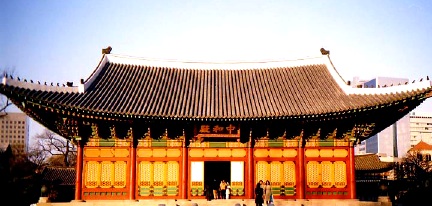Deoksugung
|
|
Template:Koreanname Deoksugung is a walled compound of palaces that was inhabited by various Korean royalty until the Japanese occupation near the turn of the 20th century. The buildings are of varying construction, including some of natural sugi, painted wood, or stucco.
The Sokchojon at the Deoksu Palace is one of the two Neo-Classical buildings on the estate. It was also the last major public constructions during the Joseon period.
In addition to the buildings at the Deoksu Palace, there is also an art museum, forested gardens, and a statue of King Sejong the Great.
History
Deoksugung was originally the residence of Prince Wolsan, the older brother of King Seongjong. This residence was dubbed 'palace' during the Seven Year War after all of the palaces was burned in 1592. King Gwanghaegun was crowned in this palace, and named it GyungWunGung. After the official palace was moved to the rebuilt Changdeokgung, it was used as an auxilary palace for 270 years and was renamed Seogung.
In 1897, after the incident when Emperor Gojong took refuge in the Russian Embassy, Emperor Gojong returned to this place, and renamed in GyungWunGung again. Expansion of the facility followed after the return. After Emperor Gojong abdicated the throne to Emperor Sunjong, he continued to live in this palace. The palace was then renamed Deoksugung, wishing for the longevity of Emperor Gojong.

